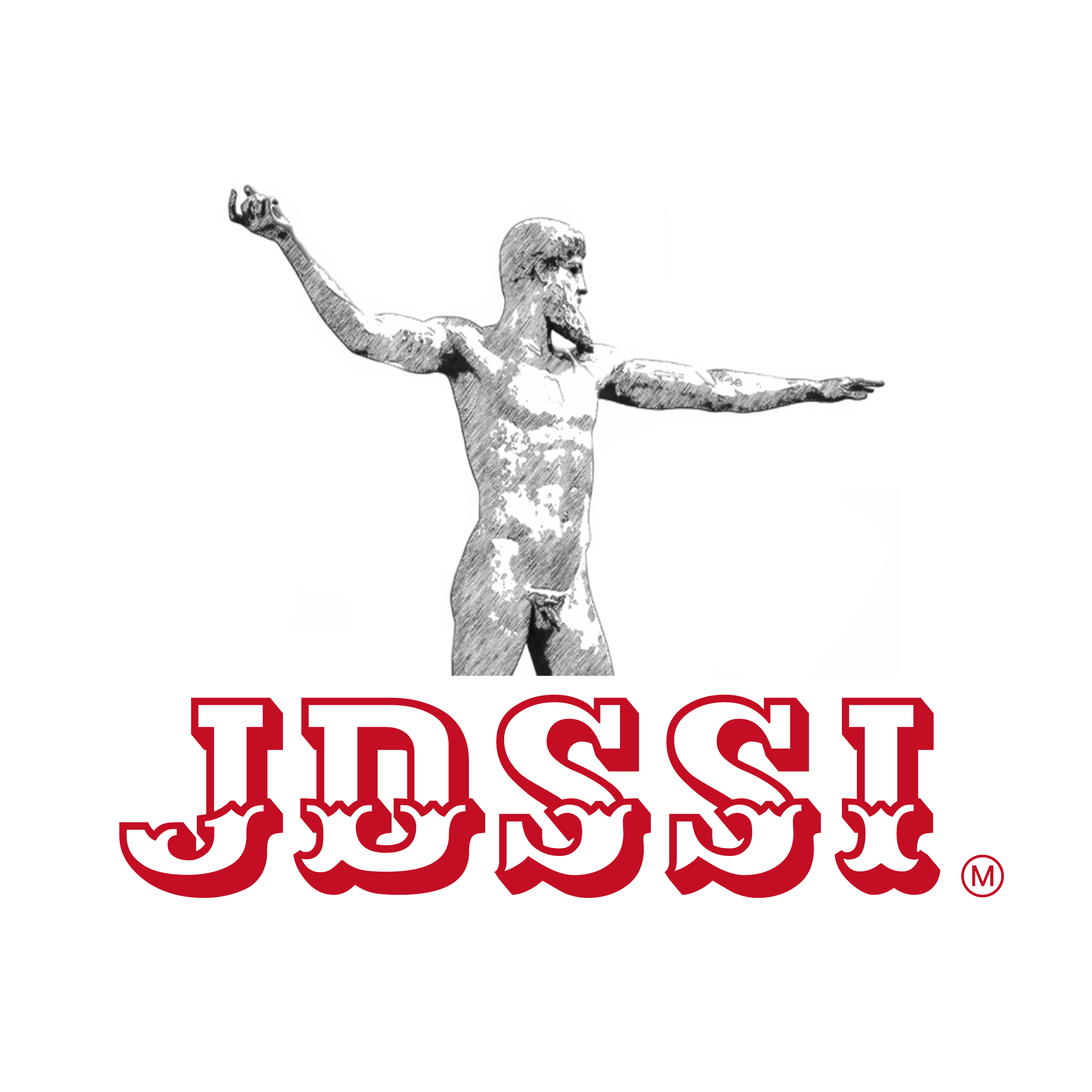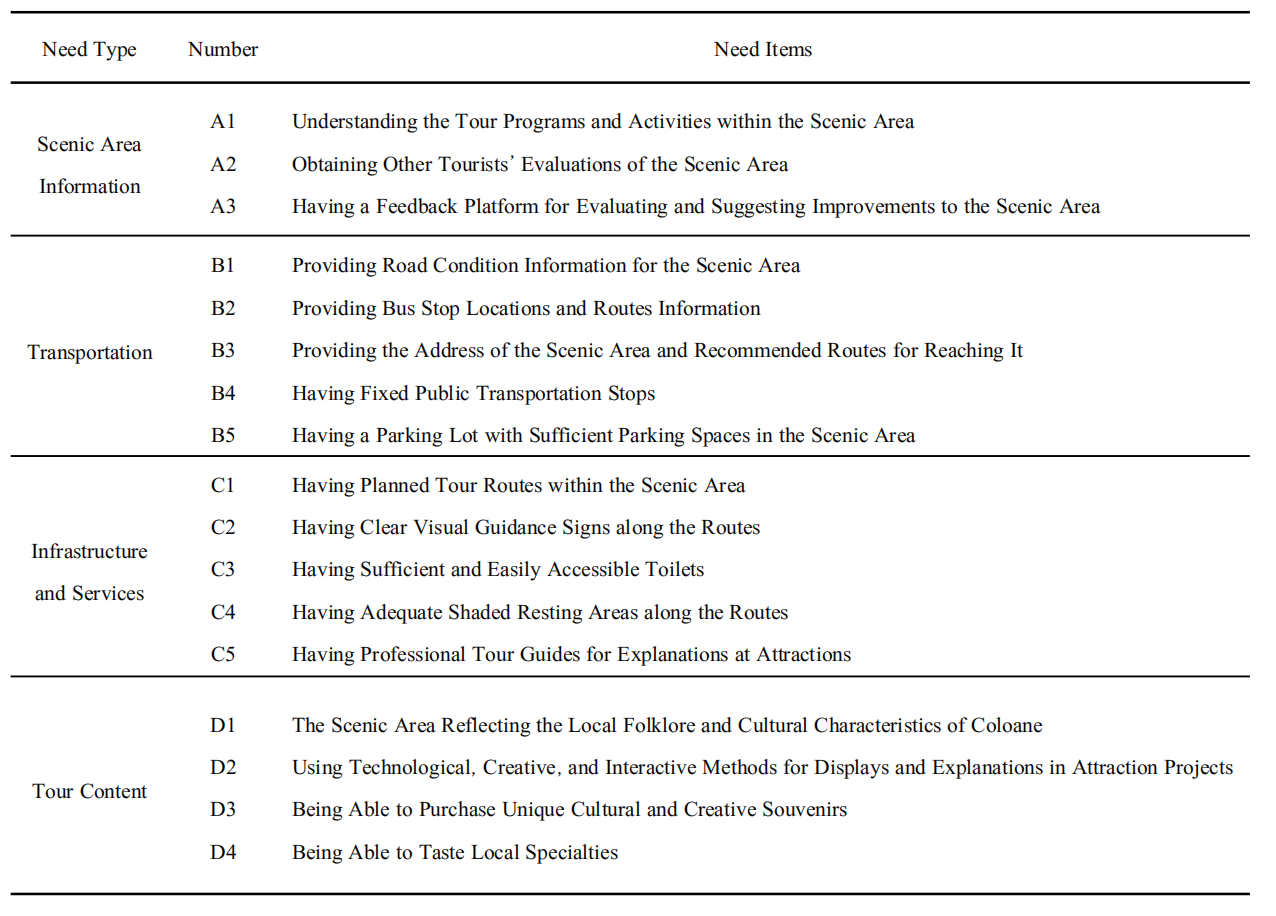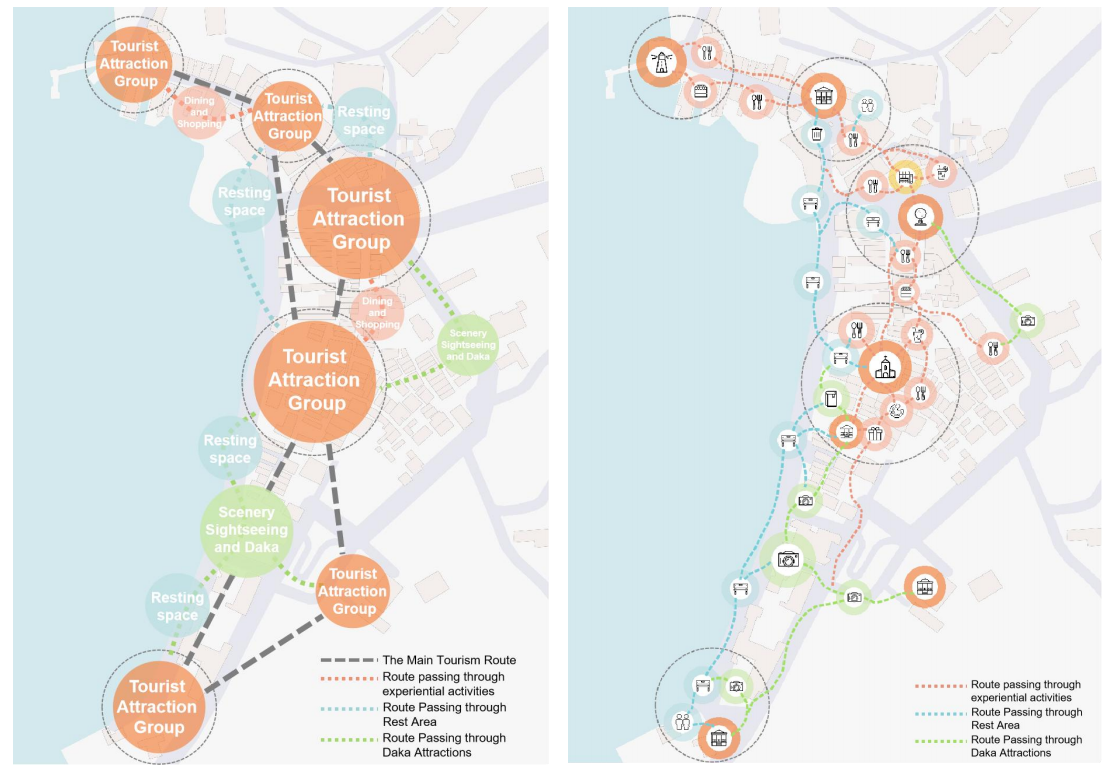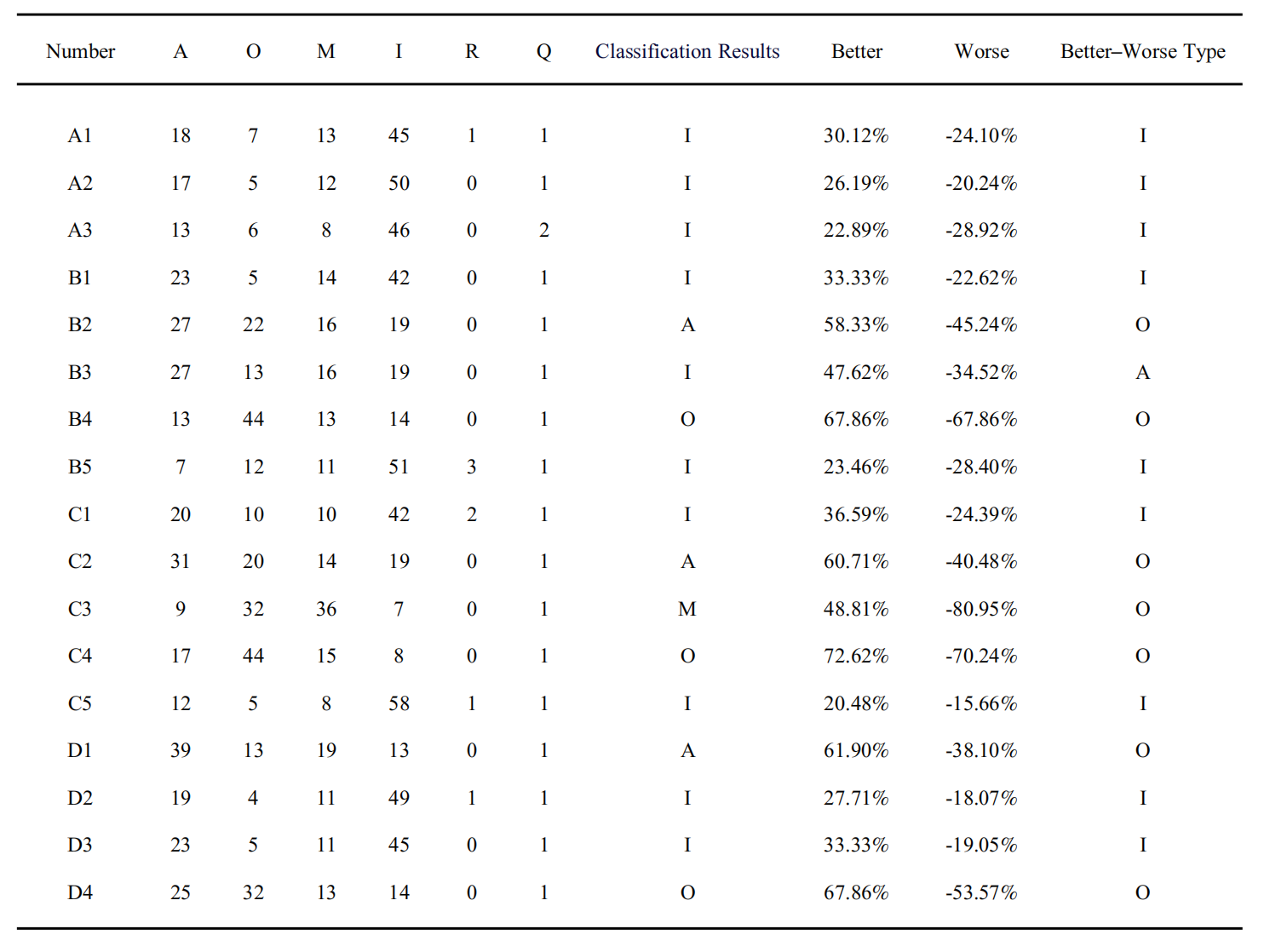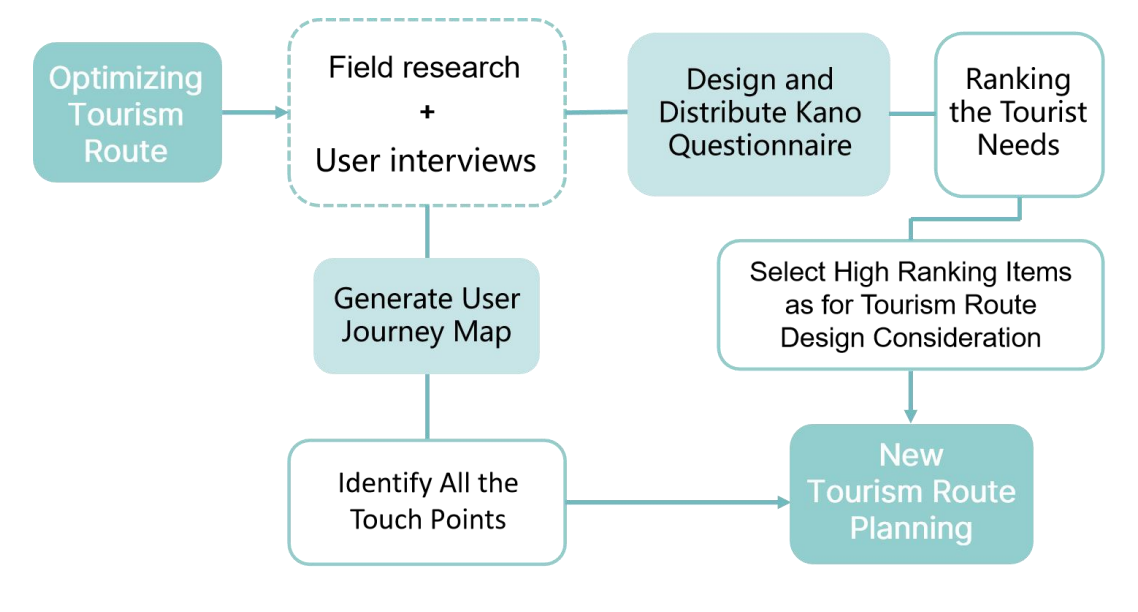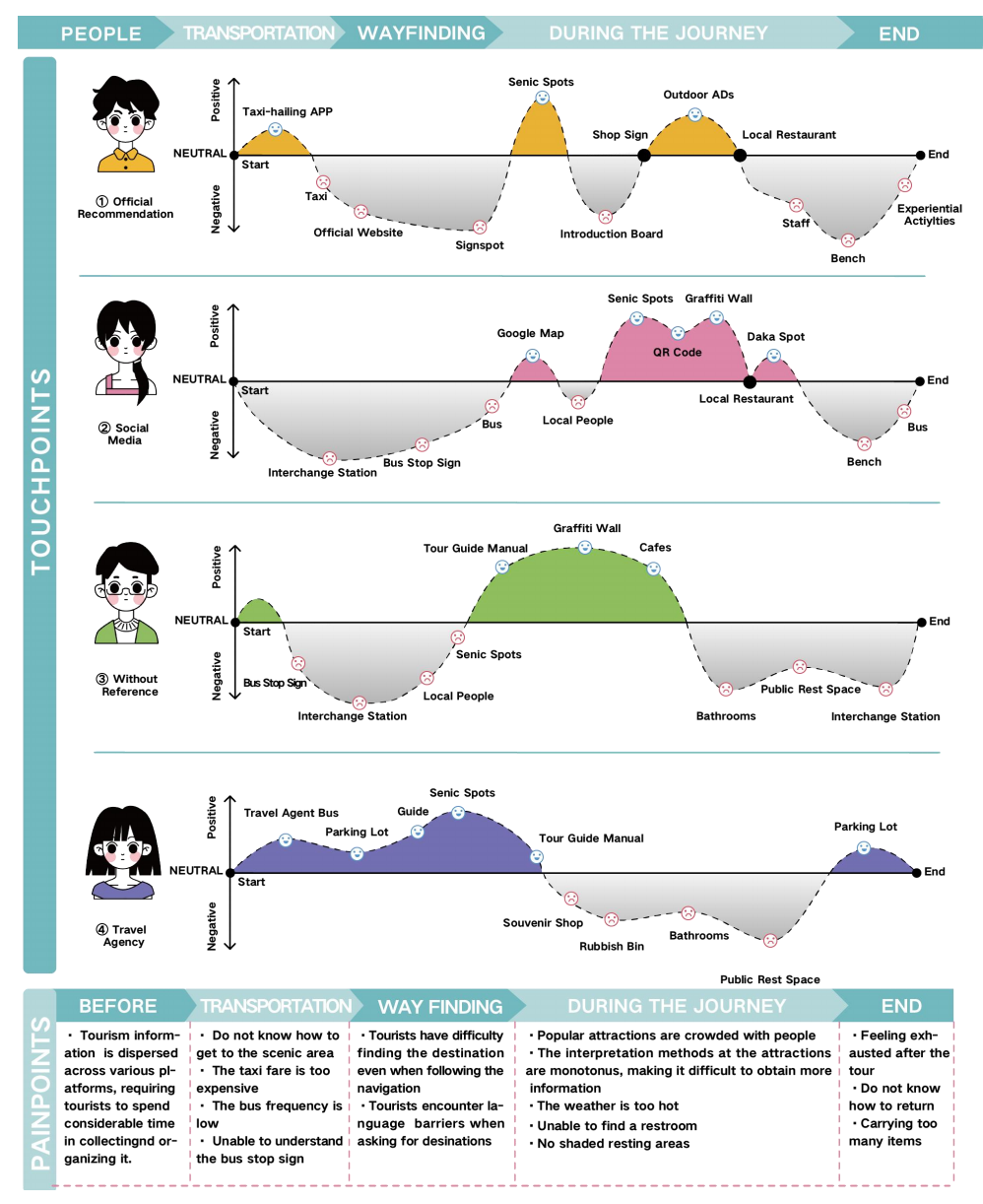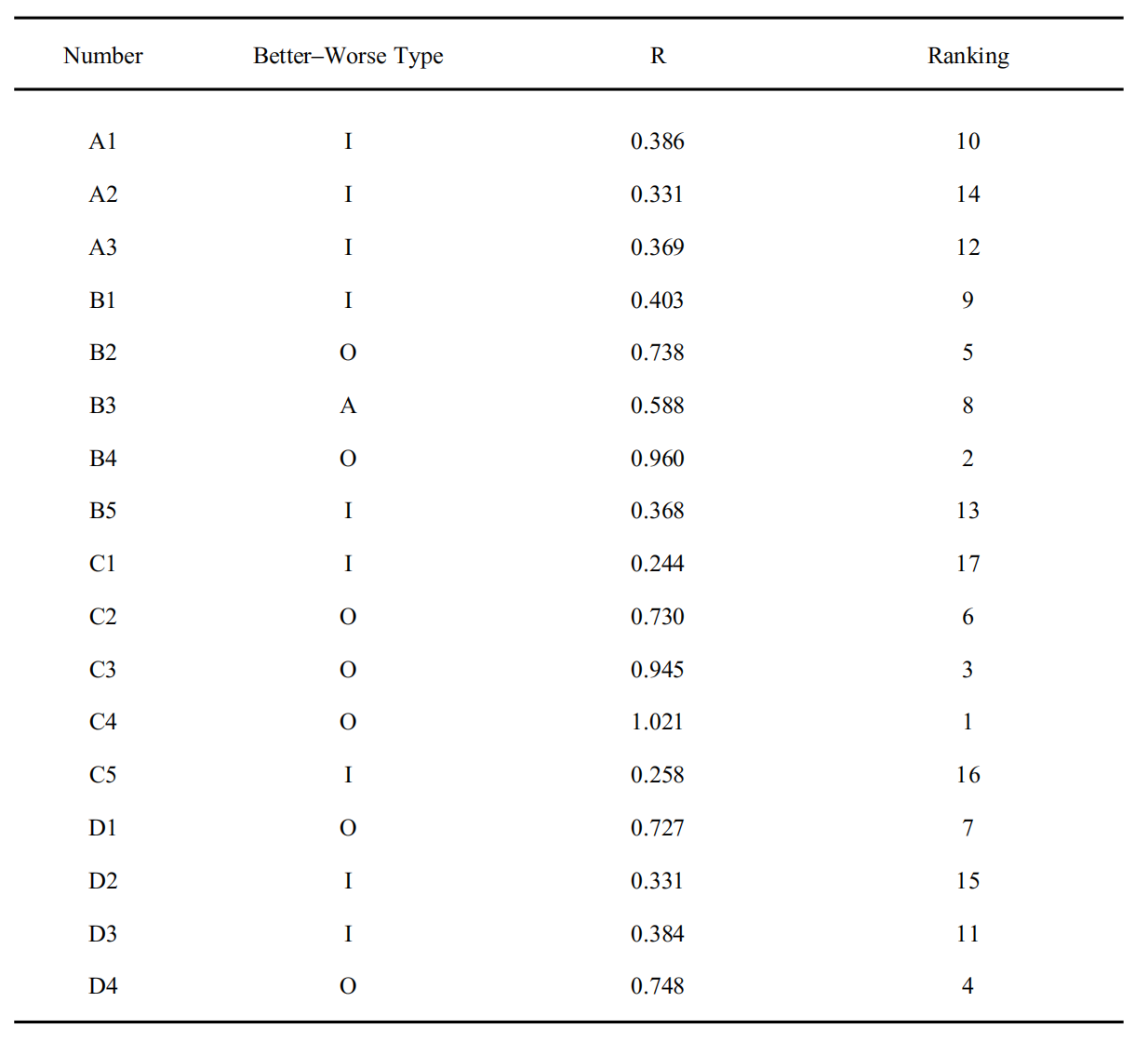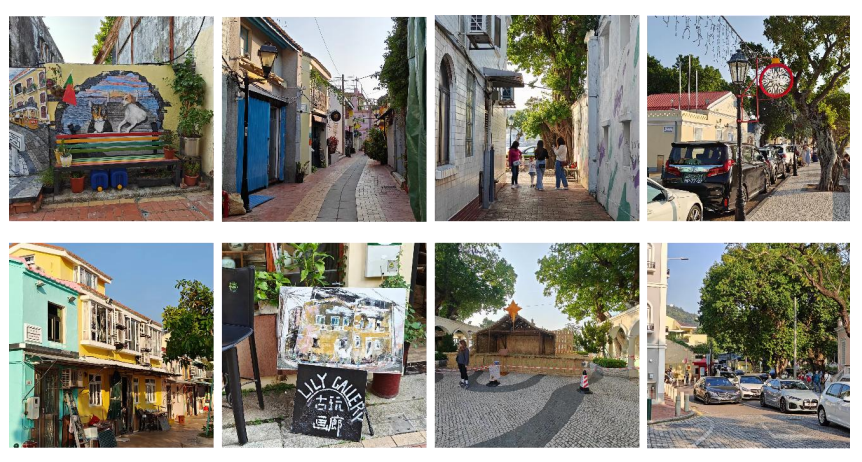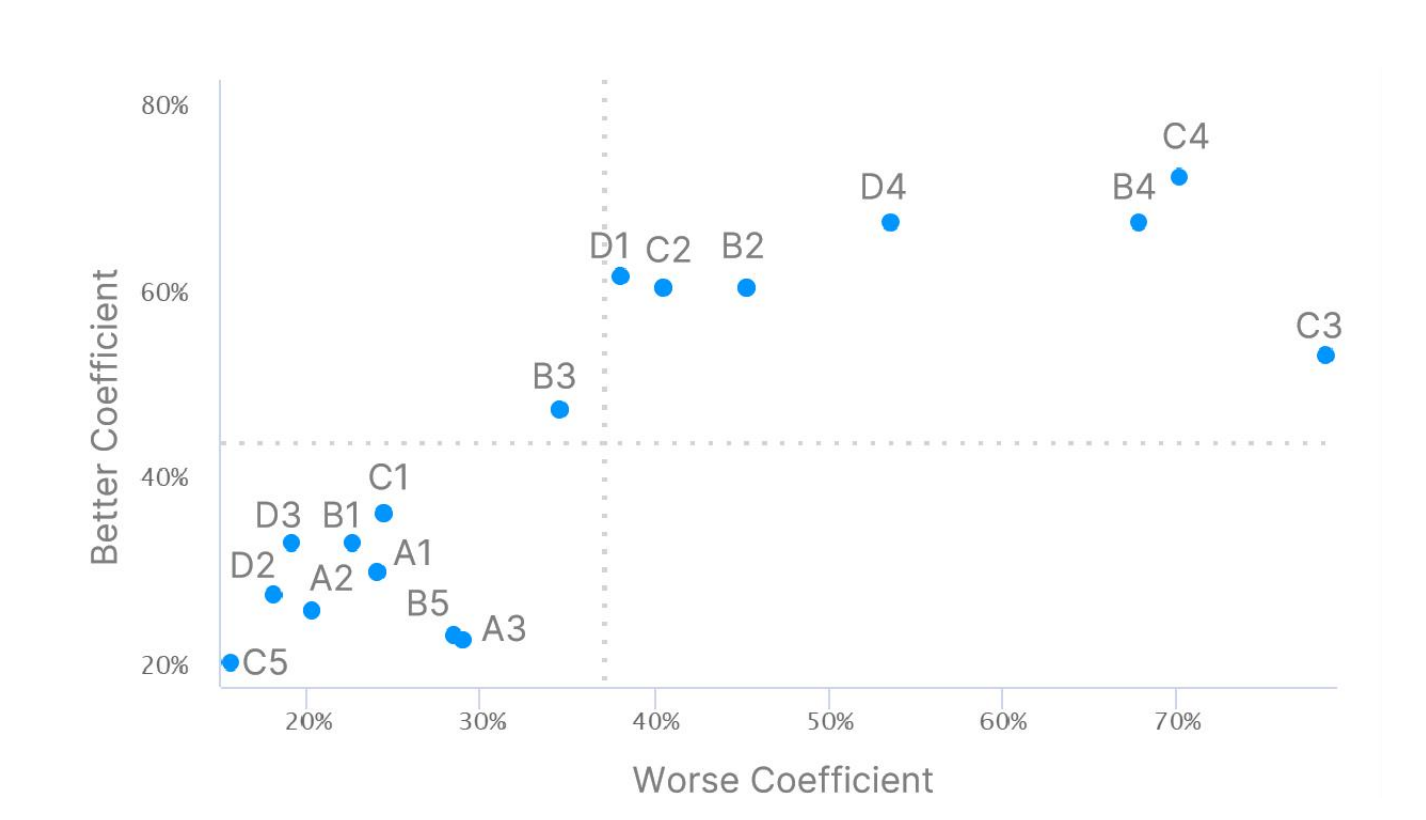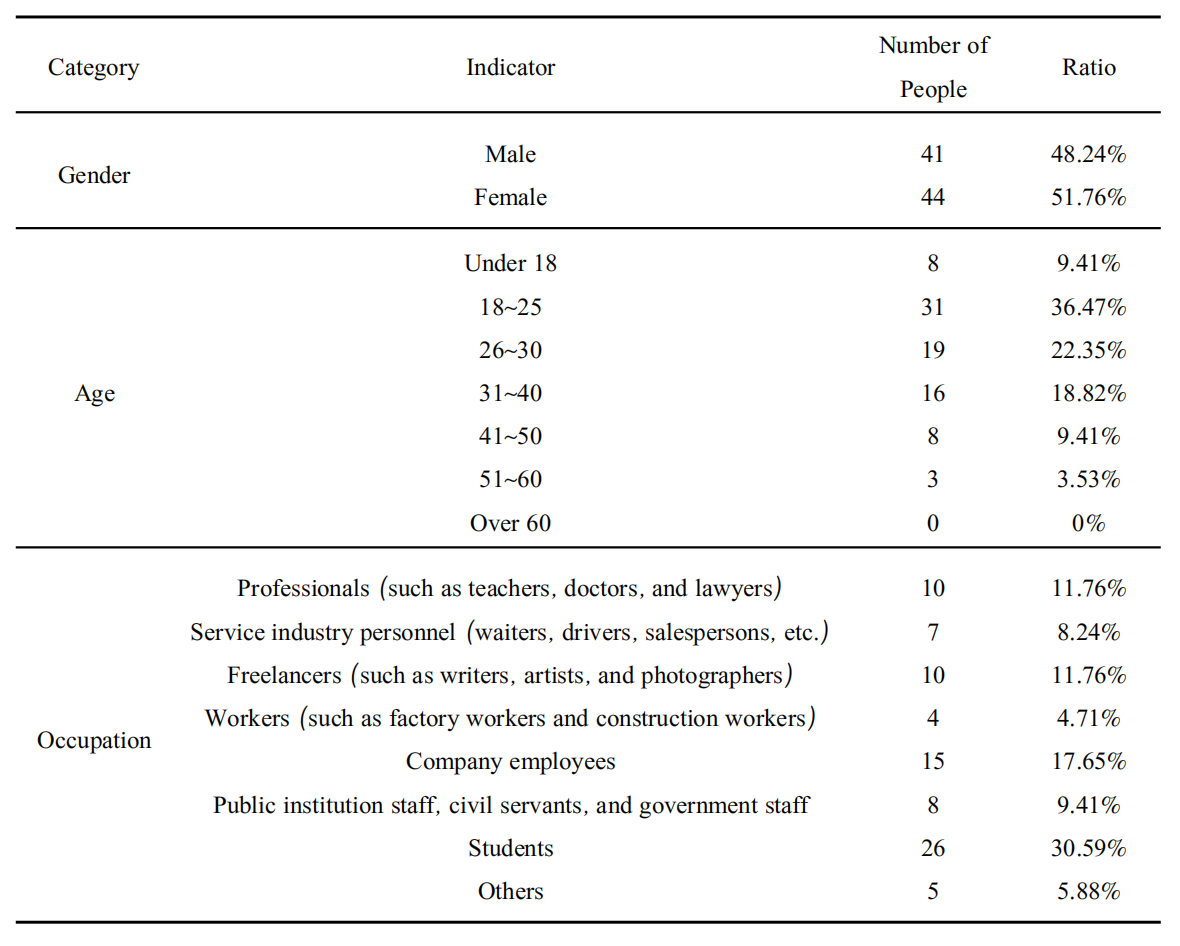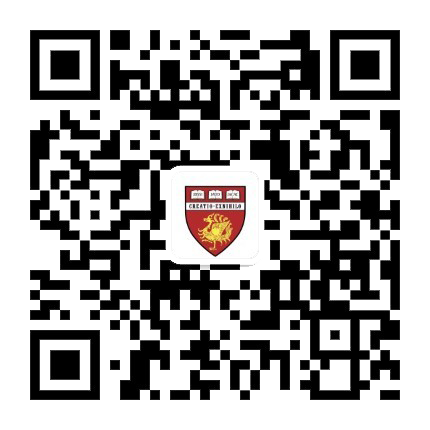Table of Contents
- Abstract
- Introduction
- Literature Review
- Analysis of the Current Tourism Situation in the Coloane Area
- Research Process
- Results
- Discussions
- Conclusions
- Author Contributions
- Funding
- Acknowledgements
- Conflicts of Interest
- References
Optimizing Tourism Routes in the Macau Coloane Area through Service Design
Table 3 shows which category each need falls into based on the largest proportion. Among them, the must-have needs include C3 (Having Sufficient and Easily Accessible Toilets). The one-dimensional needs include B4 (Having Fixed Public Transportation Stops), C4 (Having Adequate Shaded Resting Areas along the Route), and D4 (Being Able to Taste Local Specialties). The attractive needs include B2 (Providing Bus Stop Locations and Route Information), C2 (Having Clear Visual Guidance Signs Along the Routes), and D1 (The Scenic Area Reflecting the Local Folklore and Cultural Characteristics of Coloane). The indifferent needs include A1 (Understanding the Tour Programs and Activities within the Scenic Area), A2 (Obtaining Other Tourists’ Evaluations of the Scenic Area), A3 (Having a Feedback Platform for Evaluating and Suggesting Improvements to the Scenic Area), B1 (Providing Traffic Information for the Scenic Area), B3 (Providing the Address of the Scenic Area and Recommended Routes for Reaching It), B5 (Having a Parking Lot with Sufficient Parking Spaces in the Scenic Area), C1 (Having Planned Tour Routes within the Scenic Area), C5 (Having Professional Tour Guides for Explanations at Attractions), D2 (Using Technological, Creative, and Interactive Methods for Displays and Explanations in Attraction Projects), and D3 (Being Able to Purchase Unique Cultural and Creative Souvenirs).
On the basis of the calculated better and worse numerical values, a four-quadrant scatter plot was created with the better coefficient on the vertical axis, the worse coefficient on the horizontal axis, and the average of the two as the critical line, as shown in Figure 5. The first quadrant represents one-dimensional needs, including C3, C4, B4, D4, B2, C2, and D1. The second quadrant represents attractive needs, including B3. The third quadrant represents indifferent needs, comprising A1, A2, A3, B1, B5, C1, C5, D2, and D3. The fourth quadrant represents must-have needs, but according to the calculation results, this quadrant does not contain any need items.
Discussions
This study, from the perspective of service design, comprehensively employed methods such as user journey mapping and a Kano questionnaire to analyse the needs of tourists during their travel experience at the Coloane scenic area. The findings have valuable implications for optimizing the design of tourism routes within the Coloane scenic area.
Implications for designing Tourism Routes in the Coloane Area
- First, scenic area information is typically acquired in the pretrip stage. During this stage, tourists face the challenge of expending significant effort to gather scattered information about scenic areas. From the perspective of demand sensitivity, these requirements are generally undifferentiated needs. Through interviews, it was revealed that most tourists rely on social media platforms (such as TikTok and REDnote) or friends and relatives who previously visited Macau to obtain information about scenic areas. However, some also mentioned that it would be better if channels were available to access officially published information about the scenic area in Coloane. Taking all the factors into consideration, although tourists’ demand for scenic area information is not urgent, it is still worthy of consideration. Scenic areas can expand their promotional channels and strengthen the promotion of scenic area information to achieve the goal of comprehensively improving tourist satisfaction.
- Second, with respect to transportation, some tourists do not know how to obtain information on routes to the scenic area. Even some tourists who have made travel plans still find it difficult to find their way, and some mentioned that bus stop signs in Macau do not provide sufficient information, leading to uncertainty about their routes. The sensitivity ranking results show that “having fixed bus stops at the scenic area” is the most urgent need for tourists. Currently, most tourists arrive at the Coloane scenic area by bus, and there is only one bus stop within the scenic area, which has become a crucial transportation hub that all tourists pass through when entering and leaving the scenic spots. Therefore, this transportation stop can be incorporated into the design of tourism routes, and facilities at the stop can be designed simultaneously to optimize tourists’ experience while waiting for the bus. The next most important needs are “providing bus stop locations and route information” and “providing the address of the scenic area and recommended routes to the scenic area,” which align with a pain point presented on the user journey map: “tourists do not know how to get to the scenic area.” Finally, the undifferentiated needs are “providing traffic information for the scenic area" and "having a parking lot with sufficient parking spaces at the scenic area.” On the basis of interviews with tourists, it can be inferred that since transportation modes to the scenic area are relatively limited, tourists do not have many options for travel, resulting in a low demand for traffic information and parking spaces.
- The third point concerns infrastructure and services, which are in relatively high demand. The user journey map reveals that tourists reported issues such as “losing direction while searching for target attractions,” “experiencing language barriers,” “having difficulty finding toilets,” and “lack of resting spaces.” Additionally, through the ranking of tourist needs, it is evident that the need for shaded resting areas is the highest, topping all other types of needs. This is attributed to Macau’s hot and rainy climate throughout the year, thus suggesting the possibility of adding shade structures to existing resting areas. Second, tourists desire ample and easily accessible toilets. Although toilets are available within the scenic area, interviews revealed that many tourists still struggle to find them, necessitating the installation of signposts for guidance. Following this, the need for “clear visual guidance signs along the route” aligns with the previously mentioned pain point of “unable to find target attractions,” indicating that tourists still require clear visual guidance signs when navigating to their destinations.
- In terms of the content of the tour, it is evident that tourists are most interested in tasting the unique local cuisines of Coloane and wish to fully experience local folk activities and cultural characteristics. The scenic area can deeply explore and showcase its local flavors, history, and folklore by adding more engaging and emotionally resonant tourism experience projects along the tourism routes, thus enriching the visitors’ overall experience. Furthermore, when planning tourism routes, information on the most popular restaurants and souvenir shops among tourists in the scenic area can be collected and provided to tourists to facilitate their search.
These implications can assist us in optimizing and upgrading the tourism routes in the Coloane area.
Optimization of Tourism Routes Based on Differentiated Needs
On the basis of insights gained from previous research, we depicted the current distribution of scenic spots within the scenic area on the basis of the original official tourism routes. In accordance with the needs of tourists, we have refined the tourism routes, marking the locations of scenic spots, shops, and facilities (such as bus stops, rest benches, toilets, and popular scenic spots) with different icons. The guide routes are also divided into three types, namely, “routes passing through activity experiences,” “routes passing through rest spaces,” and “routes passing through check-in scenic spots,” and are presented in different colors to help tourists choose routes according to their own circumstances; see Figure 6 for detailed images. For example, if tourists desire to savour local cuisine and participate in experiential activities during their visit, they can refer to the red route. Upon arriving at the bus stop, they have the option to head north to purchase egg tarts and souvenirs, or alternatively, to head south and wander through the scenic streets and alleys of the attraction to discover various shops showcasing unique local flavors.
Introduction
In recent years, China has placed increasing emphasis on the development of its tourism industry. From a policy and reform perspective, in 2018, the National Tourism Administration and the Ministry of Culture were merged into the Ministry of Culture and Tourism. General Secretary Xi also attached great importance to cultural construction, tourism development, and the integration of culture and tourism. The “14th Five-Year Plan” proposes deepening the structural reform of the tourism supply side, promoting mass tourism and smart tourism, and providing people with more high-quality tourism products and services. At the same time, it also proposes deepening exchanges with Hong Kong, Macau, and Taiwan and supporting better integration of Hong Kong and Macau’s cultural and tourism development into the overall national development plan, such as by building the “Silk Road Cultural Tour” brand and establishing the Asian Cultural Heritage Protection Alliance. These initiatives are all aimed at achieving high-quality development of the tourism industry [1]. Since its return to China, Macau has leveraged its unique historical and cultural background, diverse folk customs, and other resources to vigorously develop its tourism service industry, achieving remarkable accomplishments worldwide. In particular, the integrated development of gambling and tourism has facilitated the flow of a vast number of personnel and enormous amounts of capital, information, and other essential elements while also boosting other service industries. In addition to the gaming industry, Macau’s historic centre was successfully added to the UNESCO World Heritage List in 2005. In 2017, the Macau Government Tourism Office formulated the “Macau Tourism Industry Development Master Plan,” which emphasized strengthening cooperation with the mainland government. With the opening of the Hong Kong-Zhuhai-Macao Bridge, an influx of mainland tourists further pushed Macao’s tourism industry towards higher-level development, with Macao striving to establish a more comprehensive modern international tourism and leisure industry.
In his study on the quality upgrading of Macau’s tourism industry, Zhou Ping summarized the fundamental characteristics of Macau’s tourism service industry, which mainly encompass the following three points: vulnerability of a solely reliant tourism industry; excessive dependency of the tourism industry on the mainland; and a limited scale of tourism and leisure services [2]. In research on the management and control strategies of the urban spatial form in Macau, Bian Lanchun mentioned the following renovation strategies for historical and cultural districts: focusing on the scale of pedestrian space, continuing to construct mixed urban spatial units, shaping a vibrant walking culture, and creating public cultural spaces with urban benefits [3]. According to the relevant literature and data, Macao’s tourism service industry needs further improvement and expansion.
Research Process
Before the research was conducted, the research process was designed. In the early stage of the research, a field survey was conducted in the Coloane scenic area to understand the overall situation of the site. Simultaneously, interviews were conducted with tourists to establish a user journey map, identifying all the touch points. On the basis of the tourist needs obtained from the interviews and with reference to the relevant literature, we designed and distributed a Kano questionnaire. The questionnaire results were collected and organized to rank the tourist needs, and the higher-ranked needs were used as the basis for designing new tourism routes. The specific research process is shown in Figure 2.
Conclusion
This study relied primarily on the theories and methodologies of service design. Through field research and interviews, we drew detailed user journey maps, identified all potential touch points that may impact tourists’ experiences, and categorized the pain points encountered by tourists at each stage of their journey. On the basis of this foundation, we referred to other scholars’ research on tourism service design and designed and distributed a Kano questionnaire. This questionnaire was used to classify tourists’ needs and prioritize them according to their level of importance, revealing the most critical needs of tourists: shaded resting areas, fixed bus stops, toilets, and the opportunity to sample local delicacies. Ultimately, we designed various types of tourist route guides, building upon official walking routes, to cater to tourists’ diverse needs and preferences, allowing them to make autonomous choices. By integrating the findings of this study, future service providers designing similar tourism routes should consider tourists’ needs while also expanding promotional channels, enhancing transportation convenience, improving infrastructure, and tapping into the unique cultural features of scenic areas to comprehensively increase overall service quality.
This research provides both data support and practical guidance for optimizing the tourism routes in the Coloane Island scenic area and can serve as a valuable reference for subsequent studies on the optimization of tourism routes.
For each of the aforementioned tourist need items, a question was posed from both positive and negative perspectives, such as “There are fixed public transportation stops within the scenic area. How would you evaluate this?” and “If this feature were not available, how would you evaluate it?;” with options ranging from “very likely,” “likely,” “neutral,” “unlikely,” to “very unlikely,” the setting of these response options was referenced from the 5-Likert scale regarding “likelihood.” This approach enabled us to gauge tourists’ satisfaction levels for these needs under different scenarios.
Data Collection and Analysis
The Kano questionnaire for this study was distributed through both online and offline channels, targeting tourists who had already visited the Coloane scenic area and those who were currently visiting the area. A total of 87 questionnaires were collected, 85 of which were valid. The characteristics of the respondents are detailed in Table 2.
Additionally, we conducted semistructured interviews with tourists, focusing on topics such as their mode of transportation, sources of travel route information, and feelings at various attractions within the scenic area. On the basis of these interviews, we also conducted nonparticipatory observations and tracked and recorded their tourist activities to gather data for the subsequent development of a user journey map.
Creating the User Journey Map
The user is at the centre of service design, and a user journey map depicts the user’s feelings and experiences throughout the service process in chronological order. It helps designers understand the user’s genuine needs and optimize service processes [23].
By constructing a user journey map for tourists visiting the Coloane urban area in Macau, we can identify their feelings and behaviours at various touch points during the tour, uncover pain points, and improve services to provide a better experience for tourists. Touch points refer to the critical moments of interaction between a user and a service. Albert from Frog Design emphasized that touch points are instants when emotions and psychological interactions are triggered during sensory interactions between users and services. Therefore, for service designers, thoroughly considering these touch points is crucial in service design. By selecting and designing each touch point, they can be leveraged as powerful tools to enhance user satisfaction and loyalty [24].
To construct a user journey map, the first step is to identify the target tourist group. Studying user groups is a vital part of the service design process [25]. On the basis of previous semistructured interviews, we determined that the officially recommended tour route would serve as the primary reference route, with other methods used for comparison. Through participatory and nonparticipatory observation, we recorded the overall tour processes of different tourist groups, identified all touch points within the tour routes, paid attention to their emotional experiences, identified their pain points at different stages, and finally integrated the information. The resulting user journey map is shown in Figure 4.
The user journey map encompasses four types of tourist groups, with each group’s travel route presented in Figure 1. We documented each tourist’s “touch points” with the scenic area in the sequence of “before - transportation - way finding - during the journey - end.” A baseline was established as a standard; touch points above the baseline indicate that tourists had better emotional experiences at those locations, whereas those below the baseline suggest poorer emotional experiences. The pain points of tourists, summarized at each stage, are depicted at the bottom of the figure.
Design and Distribution of the Kano Questionnaire
Overview of the Kano Questionnaire
The Kano model, which was originally proposed by Professor Noriaki Kano from Tokyo University of Technology, illustrates the nonlinear relationship between product performance and customer satisfaction. It can be utilized to scientifically categorize customer needs and prioritize them on the basis of their significance [26]. The Kano model categorizes factors influencing customer satisfaction into five types according to the relationships between different types of quality attributes and customer satisfaction: must-have attributes, one-dimensional attributes (or expected attributes), attractive attributes, indifferent attributes, and reverse attributes.
This study aimed to uncover the latent needs of tourists during their travel experiences within the Coloane scenic area. By conducting research through the application of a Kano questionnaire, we classified tourists’ needs into different categories on the basis of their attributes via an evaluation table that was tailored to the types of needs. Furthermore, we prioritized these needs according to their importance, providing both data support and a theoretical reference for the service design of tourism routes in the Coloane scenic area of Macau.
Design and Distribution of the Kano Questionnaire
On the basis of previous field visits to the Coloane scenic area and interviews with tourists within the attraction, as well as referencing the questionnaire scales designed by scholars such as Wei Jiaxing et al. in their research on service design for red rural tourism, this study divided tourists’ needs into four dimensions: transportation, scenic area information, infrastructure and services, and tour content [27]. According to the reliability and validity test results for the questionnaire, the Cronbach’s α value for all the questions was 0.867, the Cronbach’s α value for the positive questions was 0.858, and the Cronbach’s α value for the reverse questions was 0.873, all exceeding 0.7, indicating good reliability of the questionnaire. The KMO value of the questionnaire was 0.692, and the significance value of Bartlett’s test of sphericity was 0.000, which is less than 0.05, suggesting good structural validity of the questionnaire. The detailed classification of specific tourist needs is presented in Table 1.
Field Research and Interviews
On the basis of the initial understanding gained from the previous literature review and desk research, a preliminary understanding of the Coloane urban area in Macau was established. To gain a more comprehensive understanding of the actual tourism situation within the area, fieldwork was conducted on both a holiday (the Dragon Boat Festival) and nonholidays (including weekdays and weekends). We documented the actual conditions within the Coloane scenic area through methods such as photography and videography. Various onsite images are shown in Figure 3. The route for our field research was based on the “Coloane Village Experience and Treasure Hunt” tourism route recommended on the official website of the Macao Government Tourism Office (see Figure 1).
On the basis of the Kano model’s need categorization table, each need item corresponds to the following attributes: attractive (A), one-dimensional (O), must-have (M), indifferent (I), reverse (R), and questionable results (Q). The collected questionnaire results regarding the needs of tourists in the Coloane scenic area were categorized, and frequency statistics were calculated for each attribute. The proportion of each attribute under each need item was calculated, and the attribute with the largest proportion was taken as the primary quality attribute of that service need. The better–worse coefficient calculation method was used to analyse each need. The data on the attributes of tourist needs for travel route services in the Coloane Area, as well as the better and worse numerical values obtained from the calculation formula for each item, are detailed in Table 3.
Abstract: The Coloane area in Macau attracts many tourists every year because of the rich historical heritage preserved there; however, finding adequate tourism routes and support facilities remains challenging. Using the official tourism routes of the Coloane area, this paper creates a user journey map on the basis of field research and user interviews, identifies all the contact points, categorizes their needs according to the Kano model, and finally optimizes the current Coloane travel route. In this research, the findings indicate that tourists are most concerned about rest and shade spaces, transportation station locations and scenic activity experiences when they visit the Coloane area. The results of this study are expected to provide value for improving the tourism service experience in the Macau Coloane area.
Hao Fu
by
Lijiuchun He ,
Jing Liu *,
Faculty of Innovation and Design, City University of Macau, Macau
* Author to whom correspondence should be addressed.
JDSSI. 2024, 2(4), 53-71; https://doi.org/10.59528/ms.jdssi2024.1221a27
Received: August 26, 2024 | Accepted: October 30, 2024 | Published: December 21, 2024
Tourism Routes
A tourist route is not only the primary location for tourist activities but also a crucial component of tourism products, incorporating diverse tourism elements such as scenic spots, accommodations, transportation, and facilities. Scholar Han Fei defines a tourist route as “a route or pathway that intentionally connects a region with a series of attractions and activities to promote, at a minimum, the local tourism industry [8].” Route planning has a direct effect on tourist satisfaction. An excellent tourist route can not only effectively guide the flow of tourists, optimize the touring experience, and enhance tourist satisfaction but also promote the development of the tourism industry, forming a virtuous cycle for regional tourism economic development [9].
The design of tourism routes aims to create high-quality travel itineraries for tourists by comprehensively considering constraints such as time and distance costs and striving to maximize tourism benefits [10]. The essence of tourist route design is to integrate all the tourism resources at the destination and provide tourists with corresponding tourism content and services during their sightseeing process. From a temporal perspective, tourist route design encompasses the entire tourist activity, from the moment tourists receive tourism services until they disengage from the service providers and the trip concludes. From a content perspective, tourist route design encompasses every aspect of the tourist experience that is utilized and enjoyed during a trip, such as dining, accommodations, transportation, sightseeing, shopping, and entertainment. These aspects are intricately connected and interdependent.
The scientific design of tourism routes can enable complementary advantages among tourist attractions. Currently, the design of tourism routes at many attractions often considers factors such as the resources, market, and economic benefits of the tourist destination, as well as the physiological and psychological perspectives of tourists. Scholars have explored evaluation criteria for tourist route planning by collecting information on popular attractions and suburban road networks. They have designed tourism routes separately from the perspectives of tourist experience and shortest travel distance and have established indicators for evaluation to find routes that are practical and feasible [11]; Furthermore, scholars have proposed planning methods based on matrix decomposition and ant colony algorithms, drawing from the primary research methods employed in tourist route planning [12]; Scholar Huang Jingxiong comprehensively utilized research methods such as deep learning technology, stated preference methods, and GIS spatial analysis to conduct research on issues such as tourism flow prediction and tourism congestion prevention from the perspective of visual preference [13]; In her research on tourism routes, Han Fei introduced the concept of user personas, assigning various attributes to both tourists and attractions through a recommendation system, with the aim of satisfying tourists’ individualized needs. This study focuses on the needs of tourists and aims to identify optimization strategies for enhancing tourist route services in the Coloane Urban Area, Macau, by leveraging the concept and methodologies of service design to explore all potential touchpoints and pain points during tourists’ travel experiences in the area.
Author Contributions
Conceptualization, L.H.; Methodology, L.H. and J.L. and H.F.; Investigation, L.H. ; Visualization, L.H.; Data analysis, L.H. and H.F.; Writing—original draft, L.H.; and Writing—review & editing, L.H. and J.L.. All authors have read and agreed to the published version of the manuscript.
Funding
Not applicable.
Acknowledgements
The co-authors would like to extend deep gratitude for the guidance and assistance provided by mentors and other collaborators during the writing process of this paper.This article was presented as a speech at the 2024 International Forum on Design Service and Social Innovation, and we are very honored to have the opportunity to showcase our research findings at that forum.
Conflicts of Interest
The author declares that they have no conflicts of interest related to this research.
Literature Review
Service Design
Service design is a systematic design approach that takes user needs and emotional experiences as its starting point [4]. Its core mindset is user-centricity, embodying a people-oriented philosophy throughout the entire design process and ultimately satisfying user needs. Service design originates from the interdisciplinary development of marketing, management, and service studies and related preliminary research [5]. Views closely related to the concept of service design can be traced back to the papers “How to Design a Service” published in the European Journal of Marketing in 1982 and “Designing Services That Deliver” published in Harvard Business Review in 1984 by G. Lynn Shostack, an American service management expert. She emphasized the importance of focusing on service and planning it through the means of design. She was also the first to combine the terms “service” and “design.” In its early stages, this theory also included explorations of service innovation and service marketing practices from the perspectives of management and marketing. However, although these viewpoints are related, they differ from the widely discussed concept of “service design” within the field of design studies today [6].
The term “service design” in the current scope of design studies first emerged in the 1990s, when the British Professor of Design Management Bill Hollins proposed it in his book “Total Design.” In this book, he described how to design services as if they were products. In the same year as the book’s publication, Dr. Michael Erlhoff formally established “service design” as an independent design discipline at the Koln International School of Design (KISD) in Germany and dedicated himself to its teaching and promotion. In 2008, the Board of International Research in Design, which oversees the publication of “Design Dictionary,” provided a clear definition of “service design:” designing the functions and forms of services from the user’s perspective to ensure that they are useful, usable, and desirable for customers and from the service provider’s perspective to ensure that they are effective, efficient, and identifiable [7].
In Stefan Moritz’s book “Service Design: Practical Access to An Evolving Field,” he delves into the essence of service design from a design perspective, pointing out that service design is a type of design aimed at innovating or comprehensively improving the service experience. Service design can serve as an interface, tightly connecting service providers with users in entirely new ways to enhance the practicality, usability, and ideality of services while also bolstering their effectiveness and efficiency, ultimately delivering an unprecedented value experience to users.
With the development of the economy and social transformation, the concept and methodologies of service design are being increasingly applied to various fields, such as economics, management, and public services. This study aims to adopt a service design perspective, focusing on tourists, to gain a comprehensive understanding of their experiences and feelings. By utilizing various creative tools, such as user journey maps and service blueprints, this study supports collaborative research on tourism routes in the Coloane urban area, Macau.
Research on Tourism Service Design from the Perspective of Service Design
The purpose of tourism service design is to optimize the traveller experience and increase satisfaction through a comprehensive consideration of factors such as tourism products, locations, environments, and services by deeply understanding the needs of tourists and incorporating the thinking and methodologies of service design from the perspective of tourism services [14].
Through literature research and data collection, a review of recent literature on tourism service design has been conducted. Since 2013, domestic cutting-edge research on tourism service design has focused primarily on areas such as regional culture, interface interaction design, public facilities, and cultural tourism integration [15]. Scholar Yang Jie applied the concepts and related methods of service design to guide the scientific and forwards-thinking development of regional cultural brands, enabling them to better meet consumer needs [16]. Many scholars have explored the interaction design of service system interfaces, for example, in the context of smart cities, using service design methods and leveraging internet technology to achieve seamless interaction between online and offline tourism products, thereby optimizing the tourist experience [17]. Additionally, various scholars have focused on the elderly tourism group, addressing their specific needs by flexibly and diversely integrating information technology and other forms of service products throughout their travel activities, thereby increasing their satisfaction with tourism services [18].
The research focus of tourism service design in other countries differs slightly from that in China, concentrating on areas such as user satisfaction, public transportation, built environment, and quality of life in recent years. For example, scholars such as Font Xavier have delved into value cocreation mechanisms in sustainable tourism. They adopted a user-oriented and value cocreation approach to systematically analyse the service elements required by travel agencies and tourists in sustainable tourism and, on this basis, designed a tourism service business model rooted in sustainability principles [19]. In response to the impact of the COVID-19 pandemic on the tourism industry, an expert team led by Tedesco Silvia combined circular design with virtual participatory design concepts to promote the transformation and upgrading of traditional Sicilian architecture to develop a more attractive tourist destination [20].
Analysis of the Current Tourism Situation in the Coloane Area
Basic Overview of the Coloane Urban Area, Macau
Coloane Island, which is located in the southern part of Macau, China, covers an area of approximately 7.6 square kilometres and has a permanent population of only 28,100. It boasts the highest terrain in Macau, with rolling hills and seas on three sides. The urban development of Coloane Island can be broadly categorized into three stages: village growth, industrial expansion, and tourism emergence. In its early days, traditional fishing villages such as Hac Sa and Kau Ho were scattered along the coastline of Coloane Island, while the old town area flourished due to the promotion of sacrificial activities, gradually evolving into a town. Later, with the implementation of land reclamation and highway construction projects, Coloane Island became increasingly connected with Taipa Island and the Macau Peninsula. After Macau’s return to China in 1999, the focus of Coloane Island’s development shifted gradually towards tourism, with the continuous improvement of park construction and supporting service facilities, transforming it into an emerging tourist destination [21].
This research focuses on the Coloane urban area in the southwestern part of Coloane Island, Macau. Unlike the bustling downtown areas of other districts in Macau, this region is relatively underdeveloped, with the coastal fringes of the urban area still retaining the charm of traditional fishing villages. The main types of establishments in the urban area include government agencies, museums, restaurants and shops, religious structures, historic buildings, and private residences. The Coloane urban area attracts many tourists because of its unique natural scenery and rich historical and cultural heritage. On various social media platforms, Coloane is also recommended by many travel bloggers as an ideal spot for sightseeing and photography. By the end of 2023, the keyword “Coloane, Macau” had garnered 2.408 million views on REDnote (a popular Chinese social media platform). Therefore, this study aims to explore strategies for optimizing tourism services from a service design perspective, thereby promoting the long-term development of the Coloane urban area.
Current Status of Tourism Route Planning in the Coloane Urban Area
To preserve and protect cultural heritage, the government of the Macao Special Administrative Region (MSAR) has established the Cultural Heritage Bureau and formulated detailed regulations for the conservation of heritage buildings, with the aim of restoring historic buildings. Meanwhile, to revitalize the historic urban areas and carry out deep cultural and tourism integration, the Macao Government Tourism Office has carefully planned and launched the “Walking Tours by District” series of tourism route recommendations, which serve as references for tourists to guide them in exploring the unique landscapes of Macao in depth. “Walking Tours by District” encompasses eight themes. Initially, in 2013, four walking tours were introduced: “Historical Footprints,” “Sino-Portuguese Crossroads,” “Green Creativity,” and “Arts & Culture Exploration.” In 2014, four more routes were added, each showcasing the diverse cultural aspects of Macao [22].
Currently, the official website of the Macao Government Tourism Office provides information on the locations and maps of various routes, with markers indicating popular attractions within the regions. However, these maps suffer from issues such as limited information provided and a lack of transportation guidance, which necessitates further optimization.
On the basis of the walking route maps provided by the official website of the Macao Government Tourism Office and a schematic diagram of the “Coloane Rural Experience and Ancient Treasures Exploration” route produced by scholar Yayan Zhang, this study created a clearer walking route map. This map also arranges the attractions within the Coloane urban area in the anticipated order of visiting, as shown in Figure 1. Additionally, the study employed nonparticipatory observation to follow interviewed tourists and record their walking routes and sequences within the scenic area. On the basis of the channels through which the tourists referred to the travel routes, the routes travelled by the interviewed tourists were classified into three categories: routes recommended by social media (pink), routes organized by travel agencies (purple), and no-reference routes (green) (i.e., routes travelled by tourists who visited the scenic area directly without making any plans beforehand). The routes are illustrated in Figure 1.
References
1. Wenluo Zhu, “Research on the Renewal Strategy of Public Space in Traditional Villages under the Background of Cultural and Tourism Integration: Taking the Public Space of Sixiyan Village in Wuyuan County as an Example,” Hunan Packaging 38, no.5 (2023):94-98. (In Chinese)
2. Ping Zhou, and Xiao Zhang, “Research on the Quality Upgrade of Macau's Tourism Industry in the Future Generations of the Epidemic,” Special Zone Economy, no.5 (2023):20-23. (In Chinese)
3. Lanchun Bian, Xiaoting Wang, Da Lu and Mingyu Chen, “Study on Urban Form Characteristics and Controlling Strategies in Macao,” Journal of Urban and Regional Planning, no.z1 (2019):86-99. (In Chinese)
4. Ying Zhang, Jinsheng Lu, and Feng Zhou, “Urban Public Facilities Design Based on Service Design Thinking,” Packaging Engineering 42, no.10 (2021):303-308. (In Chinese)
5. Ping Wang, “A Review of the Origin and Development of Service Design,” Design 34, no.21 (2021):106-109. (In Chinese)
6. Ying Gao, and Xiaofeng Xu, “Service Design: A New Concept of Contemporary Design,” Literature & Art Studies, no.6 (2014):140-147. (In Chinese)
7. Erlhoff Michael and Tim Marshall, Design Dictionary: Perspectives on Design Terminology (Boston: MA: Birkhauser, 2008), 355. [CrossRef]
8. Fei Han, Lingfeng Zhou, Wenfei Gao, Yilin Han, and Jun Liu, “Tourism Route Planning System Analysis and Design,” Technology and Market 31, no.6 (2024):138-142. (In Chinese)
9. Huan Liu, “Optimization of Regional Tourism Routes and Development of Tourism Economy,” Market Modernization, no.17 (2007):265. (In Chinese)
10. Huan Liu, Shiyan Zhai, Junye Pan, Yuke Feng, and Peixue Yan, “Research on the Method of Scenic Route Design Based on the Virtual Behavior Experiment: A Case Study of Millennium City Park in Kaifeng, China,” Tourism Tribune, (2024):1-18. (In Chinese)
11. Baichuan Lu, Jieyi Yang, and Xin Wang, “Tourism Route Planning of Urban Suburb Based on Tourist Experience,” Journal of Chongqing Jiaotong University (Natural Science) 40, no.10 (2021):161-170. (In Chinese)
12. Xiaomin Yang, “An Optimization Algorithm for Travel Routes Based on Matrix Decomposition and Ant Colony Algorithm,” Information Technology and Informatization, no.3 (2022):138-141. (In Chinese)
13. Jingxiong Huang, Yuan Li, Jiaqi Liang, and Mengsheng Yang, “Research on Flow Simulation and Tourism Routes Optimization Based on Visual Preference: A Case Study of Gulangyu Island,” Tourism Tribune 39, no.6 (2024):85-100. (In Chinese)
14. Lianfan Wu, Yao Wu, and Bingdie Huang, “Innovative Design Research on Tourism Service Experience on the Oujiang River Landscape Poetry Road: A Case Study of Mount Daluo Scenic Area,” Contemporary Artists, no.4 (2023):62-69. (In Chinese)
15. Na Xu, and Lanling Huang, “Visual Analysis of Tourism Service Design Research Based on CiteSpace,” Packaging Engineering 43, no.24 (2022):204-214. (In Chinese)
16. Jie Yang, and Xunrong Ye, “Research on the Application of Regional Culture Brand under the Thinking of Service Design,” Design 35, no.9 (2022):41-43. [CrossRef]
17. Xiong Ding, Yi Liu, and Shan Liu, “Public Product and Service System Design in Scenic Areas under the Background of Wisdom Tourism,” Packaging Engineering 37, no.12 (2016):149-154. (In Chinese)
18. Yang Li, and Wenfei Ding, “Innovative Design of Cultural Tourism Service Platform for the Elderly,” Packaging Engineering 41, no.8 (2020):223-226+274. (In Chinese)
19. Xavier Font, Rosa English, Alkmini Gkritzali, Wen (Stella) Tian, “Value Co-creation in Sustainable Tourism: A Service-dominant Logic Approach,” Tourism Management 82, (2021):1-13. [CrossRef]
20. Tedesco Silvia, Elena Montacchini, and Loris Insinna. 2022. "Experimenting with New Ways of Circular and Participatory Design: The Case Study of a Traditional Sicilian Architecture Transformed for Experiential Tourism" Sustainability 14, no.3: 1360. [CrossRef]
21. Xiaodi Zheng, Xiaoting Wang, and Lanchun Bian (et. al.), “Study on Protection and Utilization Strategies of Eco-Cultural Landscape Resources in the Coastal Corridor of Coloane, Macao,” Journal of Urban and Regional Planning, no.z1 (2022):157-166. (In Chinese)
22. Yayan Zhang, and Boxun Wang, “Study on the Activation, Utilization and Conservation of Historic Buildings in Macao: A Case of the Development of Tourist Routes in Macao,” Urbanism and Architecture 19, no.20 (2022):166-170. (In Chinese)
23. Qisi Xie, and Dingbang Lu, “Social Emotion Action Expression Method of Robots Based on Customer Journey Map,” Packaging Engineering 44, no.24 (2023):84-90. (In Chinese)
24. Renke He, and Ying Hu, “Study on Design Pattern and Strategies in Service Ideation,” Design, no.1 (2015):40-49.
25. Liyan Bu, Bing Yao, Hesen Li, and Xin Meng, “Design Strategy of Supermarket Shopping Service System Driven by New Retail,” Packaging Engineering 40, no.4 (2019):13-20. (In Chinese)
26. Zhuanzhuan Wu, Junxue Zhao, and Pengjiu Sun, “Research on Innovative Design of Office Furniture Based on Kano/AHP/QFD,” China Forest Products Industry 60, no.11 (2023):52-57. (In Chinese)
27. Jiaxing Wei, and Xuanwen Guo, “Red Rural Tourism Service Design Based on Kano Model,” Packaging Engineering 44, no.4 (2023):379-389. (In Chinese)
Result
On the basis of the calculated sensitivity for each indicator, a priority ranking of the different need indicators was derived. Excluding the must-have needs, which do not contain any need indicators, the remaining needs are, first, one-dimensional needs, ranked in the following order: C4 (Having Adequate Shaded Resting Areas along the Routes), B4 (Having Fixed Public Transportation Stops), C3 (Having Sufficient and Easily Accessible Toilets), D4 (Being Able to Taste Local Specialties), B2 (Providing Bus Stop Locations and Route Information), C2 (Having Clear Visual Guidance Signs Along the Routes), and D1 (the Scenic Area Reflecting the Local Folklore and Cultural Characteristics of Coloane). Second, the attractive needs include B3 (Providing the Address of the Scenic Area and Recommended Routes for Reaching It). Finally, indifferent needs are ranked as follows: B1 (Providing Traffic Information for the Scenic Area), A1 (Understanding the Tour Programs and Activities within the Scenic Area), D3 (Being Able to Purchase Unique Cultural and Creative Souvenirs), A3 (Having a Feedback Platform for Evaluating and Suggesting Improvements to the Scenic Area), B5 (Having a Parking Lot with Sufficient Parking Spaces in the Scenic Area), A2 (Obtaining Other Tourists’ Evaluations of the Scenic Area), D2 (Using Technological, Creative, and Interactive Methods for Displays and Explanations in Attraction Projects), C5 (Having Professional Tour Guides for Explanations at Attractions), and C1 (Having Planned Tour Routes within the Scenic Area). Finally, by sorting the need indicators on the basis of their level of importance within each need category, Table 5 was obtained.
After each need indicator was categorized, it was necessary to rank the needs according to level of importance to determine the priority order of the needs. On the basis of the attributes of the Kano model, the general priority for product development is must-have needs > one-dimensional needs > attractive needs > indifferent needs. Using the scatter plot as a foundation, we conducted a secondary ranking of the need items by calculating the better and worse sensitivity. R represents the sensitivity, indicating the distance of the need indicator from the origin of the coordinates. The larger R is, the more sensitive the need indicator is to changes in tourist satisfaction and, thus, the greater its impact is. Table 4 shows the sensitivity and ranking of each need indicator.
Share and Cite
Chicago/Turabian Style
Lijiuchun He, Jing Liu and Hao Fu, "Optimizing Tourism Routes in the Macau Coloane Area through Service Design." JDSSI 2, no.4 (2024): 53-71.
AMA Style
Lijiuchun He, Jing Liu and Hao Fu. Optimizing Tourism Routes in the Macau Coloane Area through Service Design. JDSSI. 2024; 2(4): 53-71.
© 2024 by the authors. Published by Michelangelo-scholar Publishing Ltd.
This article is published under the Creative Commons Attribution-NonCommercial-NoDerivs 4.0 International (CC BY-NC-ND, version 4.0) license (https://creativecommons.org/licenses/by-nc-nd/4.0/), which permits non-commercial use, distribution, and reproduction in any medium, provided the original work is properly cited and not modified in any way.
